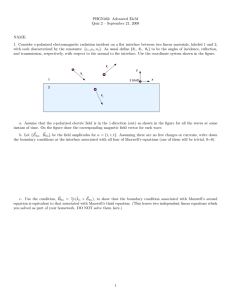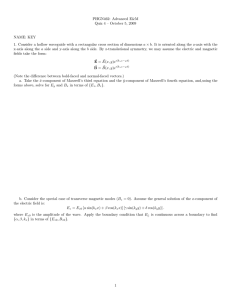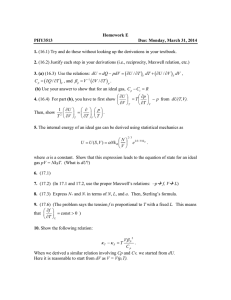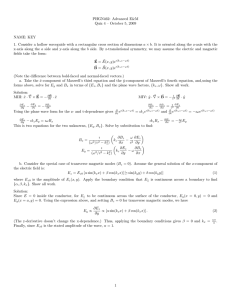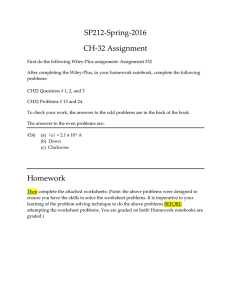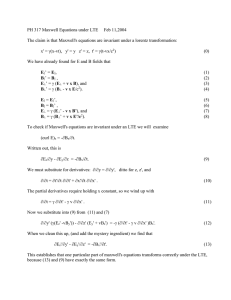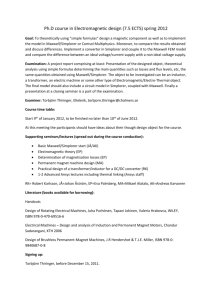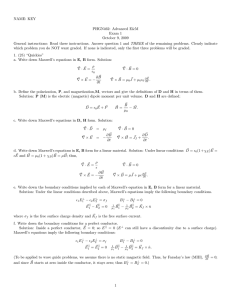NAME: PHGN462: Advanced E&M Exam 1 October 9, 2009
advertisement
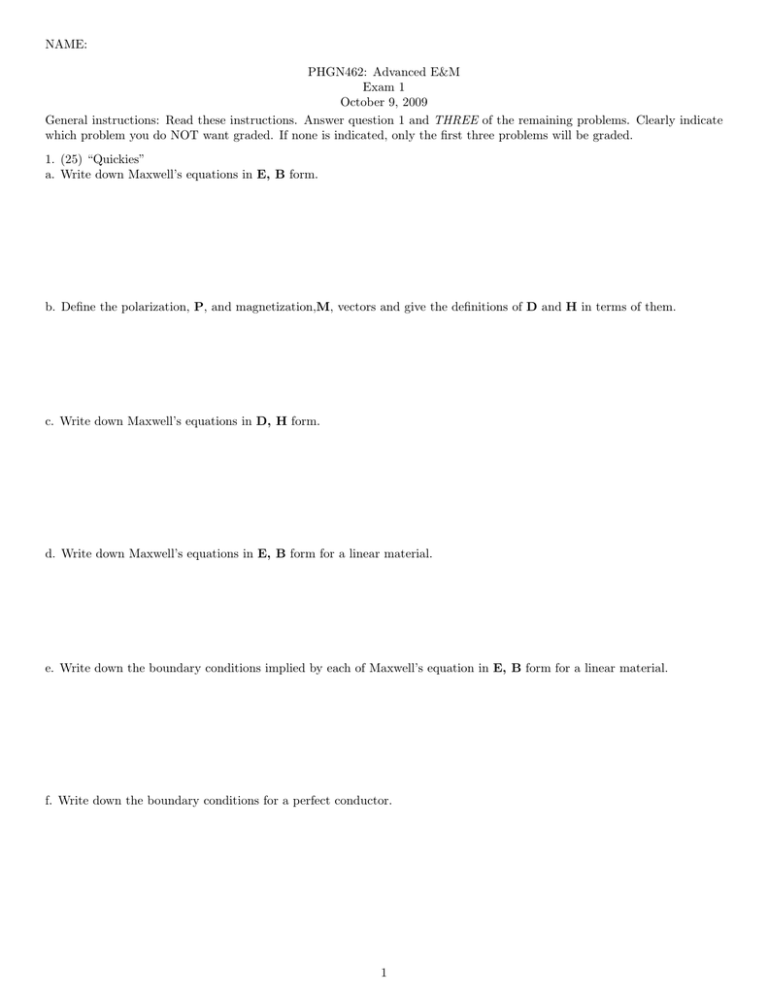
NAME:
PHGN462: Advanced E&M
Exam 1
October 9, 2009
General instructions: Read these instructions. Answer question 1 and THREE of the remaining problems. Clearly indicate
which problem you do NOT want graded. If none is indicated, only the first three problems will be graded.
1. (25) “Quickies”
a. Write down Maxwell’s equations in E, B form.
b. Define the polarization, P, and magnetization,M, vectors and give the definitions of D and H in terms of them.
c. Write down Maxwell’s equations in D, H form.
d. Write down Maxwell’s equations in E, B form for a linear material.
e. Write down the boundary conditions implied by each of Maxwell’s equation in E, B form for a linear material.
f. Write down the boundary conditions for a perfect conductor.
1
2. (25) Consider a parallel plate capacitor with circular plates of radius, R, and separation, d. Take R >> d, so you can
ignore any fringing. The capacitor at some instant of time has charge, Q, with current, I = dQ/dt, increasing the charge.
I
R
+
+
+
+
+Q
+
+
+
+
+
+
+
d
-
-
-
-
-
-
-Q
-
-
a. From Gauss’ law find the electric field inside the capacitor as a function of the charge, Q.
b. What is the potential difference between the plates?
c. Use Ampere’s law to find the magnetic field between the plates of the capacitor at an arbitrary distance, r ≤ R, from
~
the center axis due to the displacement current (0 ∂ E/∂t)
as a function of the current, I.
~ = (E
~ × B)/µ
~
d. Calculate the power delivered to the capacitor by integrating the Poynting vector (S
0 ) over the area
surrounding the interior of the capacitor. Give your answer in terms of the charge and current.
2
3. (25) Consider p-polarized electromagnetic radiation incident on a flat interface between two linear materials, labeled 1 and
2, with each characterized by the constants: {i , µi , ni }. As usual define {θi , θr , θt } to be the angles of incidence, reflection,
and transmission, respectively, with respect to the normal to the interface. Use the coordinate system shown in the figure.
kr
y
ki
1
z (out)
x
2
kt
a. Assume that the magnetic fields are all in the ẑ-direction for all the waves at some instant of time (as shown in the
figure). On the figure draw the corresponding electric field vector for each wave.
~ 0i , B
~ 0i } be the field amplitudes for i ∈ {i, r, t}. Assuming there are no free charges or currents, write down the
b. Let {E
boundary conditions at the interface associated with all four of Maxwell’s equations (one of them will be trivial, 0=0).
Maxwell I:
Maxwell II:
Maxwell III:
c. Show that
Maxwell IV:
n 1 2
n 2 1
=
n2 µ1
n1 µ2 .
(Don’t use Snell’s law).
~ 0i = ni (k̂i × E
~ 0i ) and the result from part (c), to show that the boundary condition associated
d. Use the condition, B
c
with Maxwell’s first equation is equivalent to that associated with Maxwell’s fourth equation.
3
4. (25) The wave equation for sound in a hypothetical material is
~
(∇2 − ı~
α · ∇)φ(~
r, t) = β 2
∂ 2 φ(~r, t)
,
∂t2
(1)
where α and β are positive constants depending on the elastic properties of the material.
a. For this equation to be physically consistent what are the dimensions (units) of α and β?
b. By evaluating the action of the wave equation on a plane wave traveling in the z-direction, eı(kz−ωt) , find the associated
dispersion relation, ω(k), for this material.
c. What is the phase velocity for sound waves propagating in the z-direction?
d. What is the group velocity for sound waves propagating in the z-direction?
e. Find the cut-off wave vector, kmin , below which the wave will be exponentially damped in time.
4
5. (25) Consider a hollow waveguide with a rectangular cross section of dimensions a × b. It is oriented along the z-axis
with the x-axis along the a side and y-axis along the b side. By z-translational symmetry, we may assume the electric and
magnetic fields take the form:
~ = E(x,
~ = B(x,
~
~
E
y)eı(kz z−ωt) ,
B
y)eı(kz z−ωt)
(2)
(Note the difference between the bold-face and normal-face vectors.)
a. Take the ŷ-component of Maxwell’s third equation and the x̂-component of Maxwell’s fourth equation, and,using the forms
above, solve for Ex and By in terms of {Ez , Bz } and the plane wave factors, {kz , ω}. Show all work.
~
~
~ = 12 ∂E
~ = − ∂B
~ ×B
~ ×E
MIV: ∇
MIII: ∇
∂t
c ∂t
(part b on next page)
5
b. Consider the special case of the transverse electric mode (Ez = 0). Assume the general solution of the z-component of the
magnetic field is:
Bz (x, y) = Bz0 [α sin(kx x) + β cos(kx x)] [γ sin(ky y) + δ cos(ky y)]
(3)
where {α, β, γ, δ} are constants and Bz0 is the amplitude of Bz (x, y). Using your result from part a, apply the boundary
condition that B⊥ be continuous across a boundary to find {γ, δ, ky }. Show all work.
6
